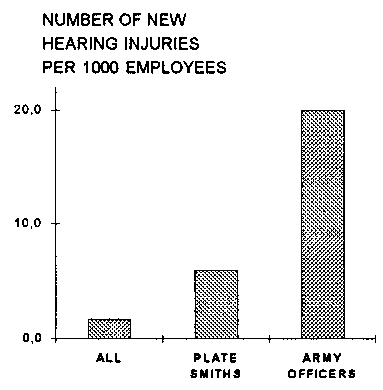
SUPPRESSORS AND SHOOTING RANGE STRUCTURES
ASEIDEN VAIMENTIMET JA AMPUMARATARAKENTEET
Ilkka Kyttälä
Rauno Pääkkönen
Translation by the authors • Tampere 1995
Shooting range and suppressor projects 1992-1993.
Financing: Ministry of Education, Ministry of Environment, Ministry of Labour,
Lapua Oy
Supervisors: Yrjö Tolonen, Pertti Kärpänen and Risto Järvelä, Ministry of
Education; Antero Honkasalo, Ministry of Environment; Seppo Palmu, Ministry of Defence;
Ilkka Heikkilä, Defence Materiel Establishment; Esa Puurtinen, Technical Inspection
Center, Juha Tikkanen and Ilkka Kiianlinna, Finnish Shooting Association; Juha Kairikko,
Finnish Hunters' Association and Erkki Kiukas Hunters' Central Organization.
Authors: Ilkka Kyttälä, Ministry of Labour; Rauno Pääkkönen, Institute of
Occupational Health; Kari Pesonen, Kari Pesonen Consulting Engineering Ltd; Juha Eväsoja
and Matti Vähäpassi, Cartridge Factory LAPUA Ltd; Juha Hartikka, BR-Tuote; Kalevi
Nurmentaus; Juhani Salo, Asetiimi Ltd; Rauli Lonka; Jorma Santala; P.T. Kekkonen; Seppo
Martiskainen and Tarmo Romppanen, Jaakko Seppänen and Veli Oravainen, Kuopio Arms Depot;
Seppo Roininen and Salme Marttio, Soil and Water Ltd; Lauri Heikkinen and Lauri
Suomalainen, PI-Consulting Ltd; Heikki Tuominen and Juhani Nuotio, Finnish Acoustics
Centre Ltd; Juhani Ollila, Institute of Occupational Health. Markku Makkonen, ministry of
Labour.
SUPPRESSORS AND SHOOTING RANGE
STRUCTURES
SUMMARY
BACKGROUND

In 1992 a joint project was established in Finland to test
suppressors of rifle caliber firearms and various shooting range structures against
shooting noise. There were several reasons for this, e.g. the adverse effects of shooting
ranges on nearby settled areas and the great number of hearing injuries among shooters,
supervisors and other people present. Suppressors and better structures seemed to offer
further possibilities in saving the shooter's hearing and reducing the area required
around the shooting ranges.
Source: 1988 population counting and 1983 to 1988 statistics of occupational diseases
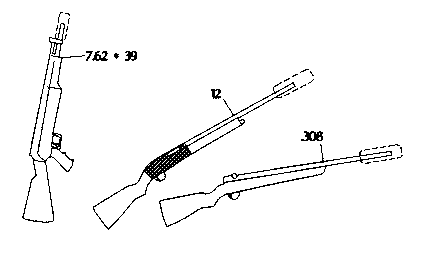
Comparative measurements were made mainly using cal. 7,62 Kalashnikov-Valmet M62 assault rifles, common .308 caliber hunting rifles and 12 cal. shotguns, with and without suppressors. The purpose was to test the acoustic and other essential properties of the suppressors, bullet noise barriers and other structures and their effects on shooting. After the tests and reports a summary for information purposes was produced, which - after statements - was corrected to get the present form:
MOST IMPORTANT RESULTS AND
CONCLUSIONS
(Only the "new findings")
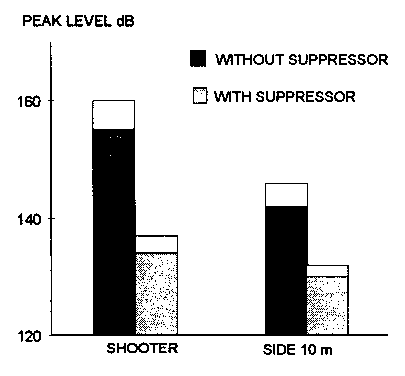
1a ATTENUATION EFFECT, SUPPRESSORS
All rifle suppressors reduced the shooter's exposure from the original 160 ± 3 decibels
to below the EU risk limit 140 dB. Differences between brands were small. Shotgun
suppressor prototypes approached the limit only when used with subsonic cartridges. At the
bystander's and trainer's positions noise reduction was similarly effective. Environmental
noise attenuates almost as well in back and side sectors. The front sector is dominated by
ballistic noise, which is not affected by suppressors. Bullet noise, however, is
concentrated in higher frequencies than muzzle blast and thus attenuates faster when
propagating.
1) Cal. .22 suppressors were most effective; attenuation more than 30 dB. On
hunting rifles the same effect was achieved only with an oversized prototype made by Jorma
Santala.
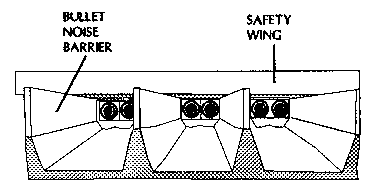
1b ATTENUATION EFFECT, BULLET NOISE EMBANKMENT AND
BARRIERS
An obstacle of about 2,5 m - embankment, barrier or combination of them - attenuates the
bullet noise by 10 to 20 decibels. The most advantageous results are obtained when the
distance of the flight path from the barrier is less than one meter and it goes two meters
lower than the top of the barrier; or in other situations where the proportions are
similar, e.g. in a canyon. The barriers can support each other by connecting them with
overhead safety wings.
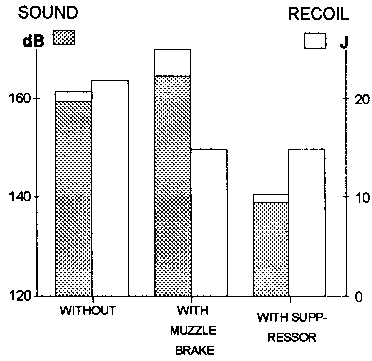
2 MUZZLE BRAKES? RECOIL?
All brands of tested muzzle brakes increased the shooter's exposure by 5 to 10 dB. The
increase in noise exposure is proportional to the recoil reducing effect of the muzzle
brake. Replacing it by even a modest suppressor may thus produce a considerable 20 dB
improvement at the shooter's position. This principle is valid for all weapons equipped
with muzzle brake. Suppressors reduced recoil energy by 20 to 30 per cent, or about as
much as muzzle brakes. They also prevented muzzle climb of assault rifles, firing
full-auto bursts or continuous rapid fire.
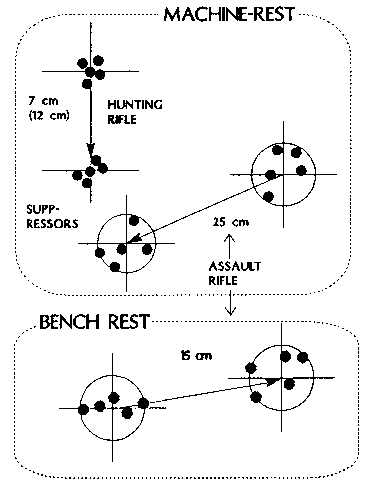
3 ACCURACY?
Suppressors did not have any notable adverse effect on shooting accuracy. The best group
diameters of assault rifle hits were achieved with suppressors. The mounting of long
extensive suppressors must, however, be done with great skill.
4 SHIFT OF GROUP?
When the suppressor (or equal weight) is mounted on the barrel muzzle, the center of the
group of hits of hunting rifles was usually shifted down by about 10 cm (shooting from
machine-rest, target at one hundred meters). For assault rifles correspondingly 25 cm left
and down, but when shooting from bench rest about 15 cm right. The reason for this shift
are changed vibration properties. It is compensated by normal re-adjustment of the sight.
When shooting from a machine-rest the vibrations change in a way, which does not represent
the real use.
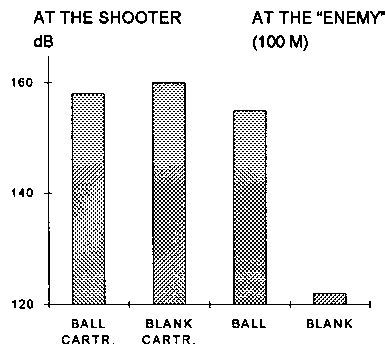
5 BLANK CARTRIDGES?
When shot close, blank cartridges can be louder than bulleted ones and they indeed cause
most of the acute hearing damages of conscripts. The simulated gunfire should be achieved
with methods 25 dB less loud than at present. The tested suppressor models do not apply
for Finnish wood-bulleted military blank cartridges. However, they apply for usual blank
cartridges with folded head. Harmless theatre weapons which sound "real" are
also available. Shooting indoors with non-suppressed blank cartridges generally means the
risk of immediate loss of health.
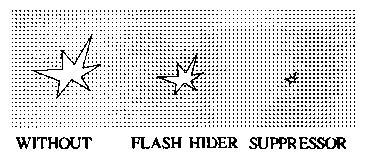
6 MUZZLE FLASH?
Suppressors hide the muzzle flash and effectively prevent the movement of foliage, grass
or twigs and puffs of sand or dust.
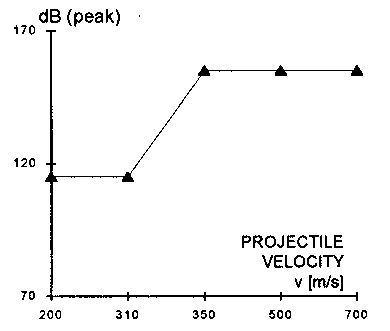
7 BALLISTIC NOISE?
The ballistic "whiplash" noise of a bypassing bullet (around 155 dB at 0,65
meter distance) is an unavoidable environmental problem, if the velocity of the projectile
exceeds the velocity of sound in air (from 310 to 350 meters per second depending on the
temperature and air pressure). No suppressor can prevent bullet flight noise. The
diameter, length and shape of the bullet affect only slightly. The ballistic noise does
not affect the shooter's exposure. Ballistic noise concentrates in higher frequencies and
thus attenuates, when propagating, faster than the muzzle blast.
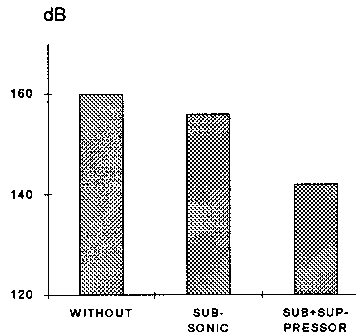
8 BALLISTIC NOISE OF SHOTS?
The ballistic noise of the pellet swarm (and the cup) can be even louder than the muzzle
blast. It strongly increases the peak levels in the front sector and slightly to the side
and backwards. Good results can be obtained only when using subsonic cartridges (v0 around
300 m/s). For the two prototypes, peak levels of 142 and 144 dB were measured at the
marksman's ear.
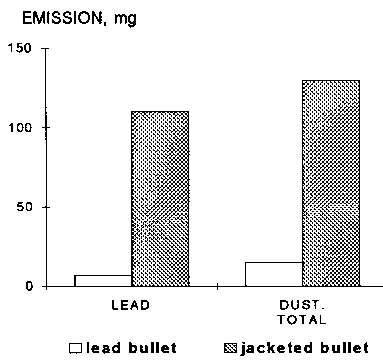
9 LEAD VAPOR EMISSION? UNBURNED POWDER?
Unjacketed bullets produced many times more lead vapor than jacketed ones. Also .22
caliber weapons produce lead vapors. Lead concentration can become a health problem at
inside shooting ranges. Suppressors make a part of the lead emission harmless by
solidifying it as card. Suppressors also burn a part of the otherwise not burned,
sensitized powder that may cause a fire or even explosion risk in insufficiently cleaned
indoor shooting ranges (five persons died in this kind of accident in Argenbühl, Germany
1993). On the other hand, it is possible that powder can build up inside a suppressor and
cause a risk of explosion (cases not known).
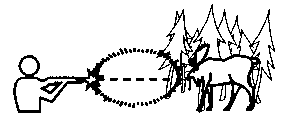
10 POACHING?
Suppressors do not decisively favor poaching or other criminal activity since they do not
affect the bullet noise. The bass tuned 130 - 140 dB sound of the suppressed muzzle blast
is also heard quite far, yet is not so disturbing. (Complete suppressors only exist in
cinema). Because of the prejudice caused by the old hunting legislation, a person who
hunts with a suppressed gun may have to carry a copy of the new law (615/93) for a long
time.
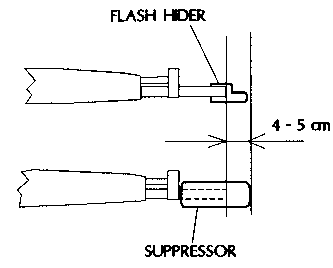
11 ADDITIONAL LENGTH/WEIGHT?
The new telescoping suppressors increase the length of firearms by only a few
centimeters and are not vulnerable even in harsh use. A steel suppressor increases the
weight of an assault rifle by approximately 10 per cent (from 3.6 kg to 3.9 kg, for
example), or - if it replaces a muzzle brake or a flash hider - only about 5 per cent;
aluminum suppressor even less.
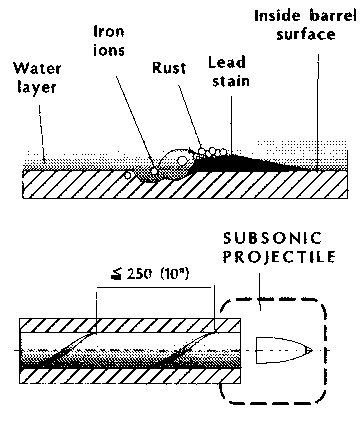
12 DURABILITY? CORROSION? OPERATIONAL CERTAINTY?
Steel suppressors seem to withstand continuous rapid fire, aluminum suppressors only in
limited amounts. In automatic weapons the increase in the gate pressure can cause problems
in mechanisms. For them further research is needed. The condensed water and lead can cause
corrosion in untended weapons: After use the suppressor has to be disconnected and/or the
barrel oiled.
To be properly stabilized, long bullets, which are used in subsonic cartridges, need the
pitch of rifling to be less than 10 inches (generally 12 "). Instability of the
bullet may, at least with long frontally mounted suppressors, cause contact with the
suppressor structures, loss of accuracy and/or damage to the suppressor.
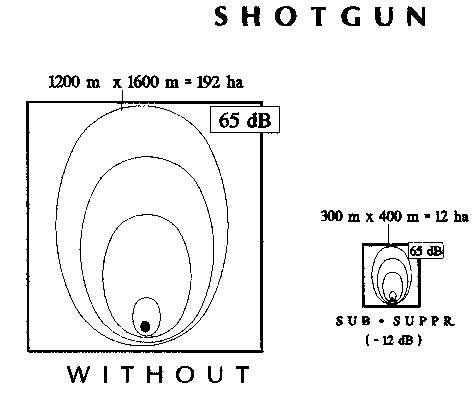
13 NEED OF LAND? EMBANKMENT?
If only suppressed firearms are used (presumed average attenuation 12 dB), the land
requirement is reduced to 1/16* or even smaller. This is valid as such at shotgun ranges
if only subsonic cartridges are used. On rifle and pistol ranges proper bullet crack
embankments and/or barriers may be necessary if natural obstacles do not exist. (Don't
place a range on a hill).
* If noise level decreases by 6 dB, distance to the neighbor can be halved.
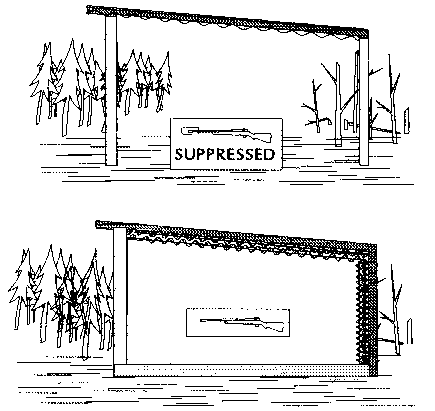
14 SHOOTING PLACE SHELTERS?
No shooting place constructions are needed when only suppressed weapons are used. If a
shed is wanted for other reasons (e.g. against rain), it should have no walls and the
ceiling should be lined with sound absorbing material like glass wool. At indoor shooting
ranges (and under roofs) only a modest lining is necessary when only suppressed firearms
are used. For unsuppressed weapons a thick layer of absorbtives and a solid structure (at
least 20 kg/m2) is required, if there are neighbors in the same building.
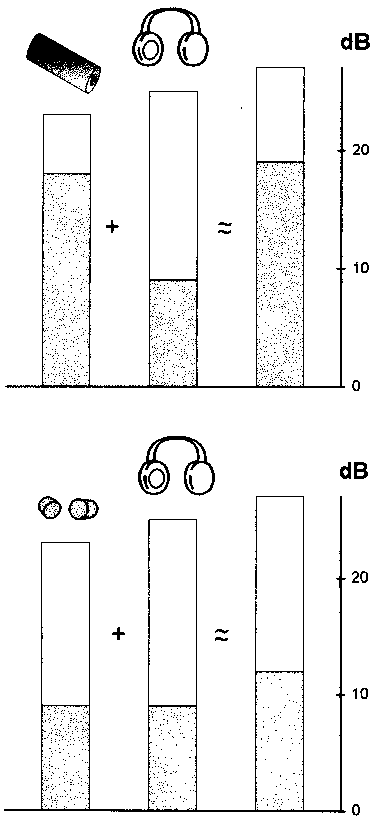
15 HEARING PROTECTORS?
The combined attenuation of protector and suppressor seems to remain modest. However, even
when shooting with a suppressor it is good to wear (light) protectors: they help to
concentrate.
In maneuvers, theatre or cinema production or exercises etc. all participating people
should absolutely have hearing protectors, if present blank cartridges are used without
suppression. The first shot is the most dangerous to hearing. If both shooters and
bystanders use protectors in advance, and conscientiously, and the protectors are of an
adequate type and fitted in, the protection is nowadays reliable. Large, heavy cups
with stiff sealing discs and great frame force are suitable, expanding plugs as well. For
heavy weapons double protection, cups + plugs, is used. Even that is not always enough.
(Combined effect of cups and plugs is modest).
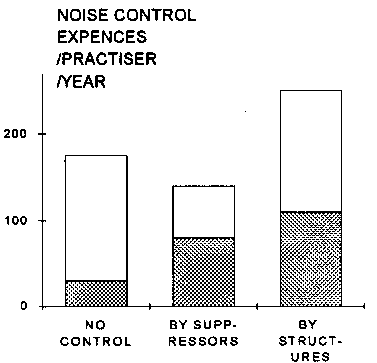
16 EXPENSES?
The unit price of a mass-produced suppressor may be reduced to about 200 to 300 FIM (20 to
30 £). The cost-effectiveness of suppressors is already now better than that of any
shooting place constructions or hearing protectors.
The integrated noise control expenses for all Finnish outdoor shooting ranges, three
alternatives:
"Traditional" (no noise control, new range acquired further away if
difficulties);
trial and protector expenses 124 mio FIM (Assumption: associations own the land),
Structure oriented; embankment, barrier. shelter and protector expenses 290 mio.
Suppressor oriented; suppressor, cartridge and embankment expenses 143 mio, about
100 FIM (10 £) per practiser/year.
* Calculations are based on source 7 for a 20 year period. They do not include any
expenses arising from hearing damages. As an average price of a suppressor, 850 FIM has
been chosen.
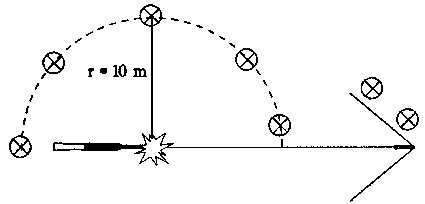
17 MEASUREMENT?
The attenuation, or more precisely the insertion loss, of suppressors for rifle caliber
firearms can be measured with sufficient accuracy for most practical purposes by a
four-point method in free field*. The insertion loss is measured for rear sector and, if
necessary, also for front sector with bullet noise eliminated.
* Work item proposal: Acoustics. Measurement of impulsive noise emission of rifles
shooting supersonic projectiles. Engineering methods.
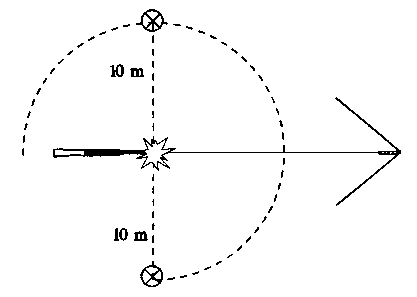
18 INSTANT MEASUREMENT
Survey type measurements with only one microphone can be made by a simplified method: one
second exposure level SEL (LAX, LE1s)
is measured 10 meters aside for five shots with and without suppressor. The ballistic
crack has a negligible influence in this point and the measurement results obtained here
represent fairly well the mean of encircling measurement results. Only combinations
representing the same caliber class can be compared by this method.
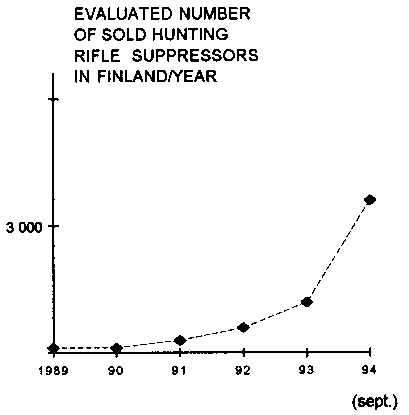
19 VIEWS
Nowadays every engine driven vehicle or machine has an efficient muffler: attenuation
several tens of decibels. The newest active control applications attenuate even the lowest
frequencies down to background noise level*. For firearms active noise and vibration
(shock) control is just beginning? Control of noise and other emissions is probably mainly
transferred to designers of weapon factories, where it belongs; e.g. a common two-barreled
shotgun is difficult to be attenuated afterwards. This way also the reliability of
functions is best optimized.
* Herdouin L et al.: An anti-pulsatory device used as an active noise control
system in a duct. Acta Acustica 1 (1993) pp. 189-198.
REPORTS:
1 Työsuojeluhallitus, Selvityksiä 1/93, Vaimentimien mittaukset 1992,
Tiivistelmä. Tampere 1993, 33+14 s. (Out of stock)
2 Opetusministeriö, Liikuntapaikkajulkaisu 39, Ampumaratojen melu- ja
turvarakenteiden kehittäminen. Suomen Ampujainliitto ry, MV-konsultit/Maa ja Vesi Oy,
Insinööritoimisto Kari Pesonen Oy. SVUL-paino, Helsinki 1993, 79 s.
3 Opetusministeriö, Liikuntapaikkajulkaisu 38, Sisäampumaratojen
suunnittelu- ja käyttöopas. Suomen Ampujainliitto ry, Projekti-insinöörit Oy.
SVUL-paino, Helsinki 1993, 43 s.
4 Pääkkönen R, Kyttälä I: Työhallinnon julkaisu 29,
Kiväärien ja pistoolien äänenvaimentimet, Loppuraportti 1. Työministeriö, Tampere
1993, 96 s.
5 Pesonen K: Äänenvaimentimien vaikutus luotiaseiden laukausääniin
ja ympäristömeluun. Ympäristönsuojelutekniikan julkaisuja 3/1994. Teknillinen
korkeakoulu, ympäristötekniikan laboratorio. Espoo, 60 s.
6 Pesonen K: Äänenvaimentimien vaikutus haulikkojen laukausääniin ja
ympäristömeluun. Ympäristönsuojelutekniikan julkaisuja 2/1994. Teknillinen
korkeakoulu, ympäristötekniikan laboratorio. Espoo, 87 s.
7 Kukkola A: Ampumaratamelun yhteiskunnalliset kustannukset.
Diplomityö. Lappeenrannan teknillinen korkeakoulu. Tuotantotalouden osasto. Lappeenranta
1994.
8 Kyttälä I: Vaimentimet ja ampumaratarakenteet, yhteenveto. Sisäisen
lausuntokierroksen -94 yhteenveto. Moniste. Työministeriö. Tampere 1994.
Original publication:
Kyttälä
& Pääkkönen: Aseiden vaimentimet ja ampumaratarakenteet
Back to Suppressor Project Page
Index Main General Rifles
50 BMG SMG
MG AR Contact Links
Measuring